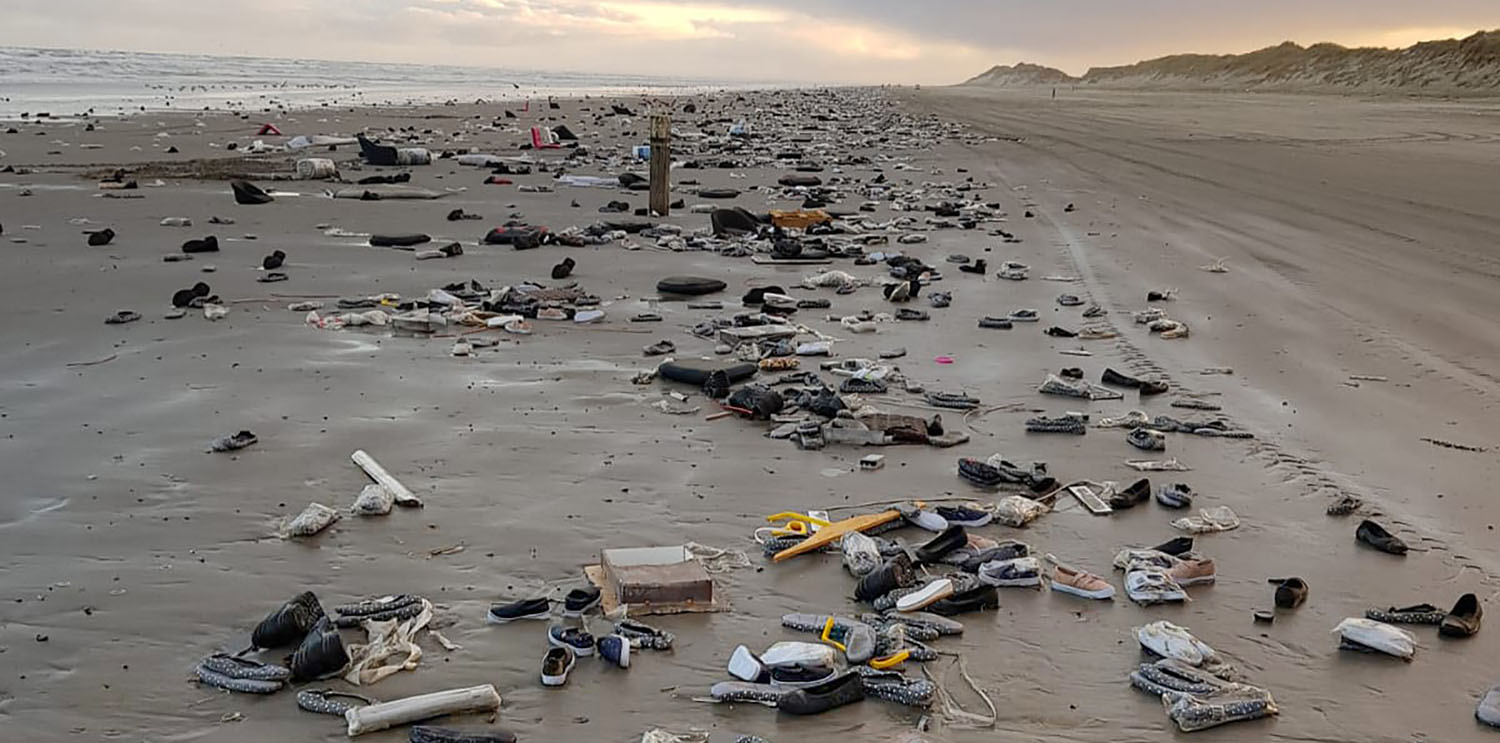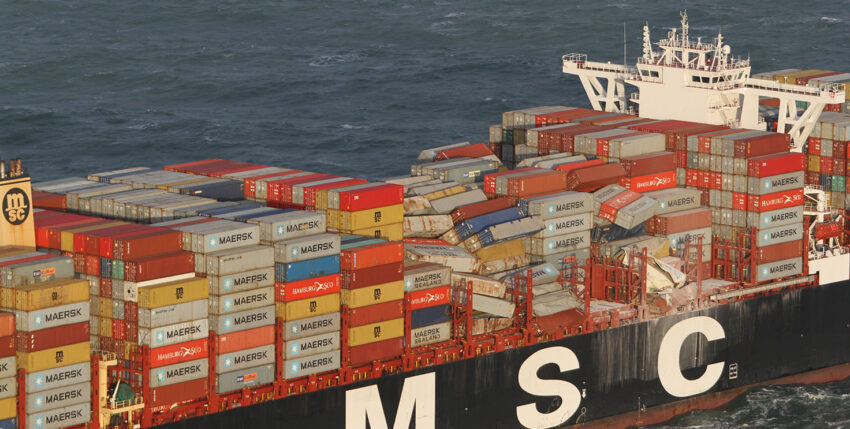The maritime community never tires of emphasising the importance of free sea routes and global trade. Without free maritime trade there can be no prosperity, without free sea routes there can be no security. Behind these political aspects, however, we must not overlook the fact that we are dealing with extreme logistical, technical and financial dimensions. It is also about power, profit, jobs and prestige. Ships are becoming ever more gigantic, the cargoes ever larger. Competition is fierce and profit margins are small. Precarious jobs, dubious loading practices, terrorism, smuggling and neglected environmental protection are the downside of prospering world trade. Does profit come before safety?
Heavy losses in winter
There are roughly five to six million containers at sea every day. It is known that thousands of them regularly go overboard every year. The World Shipping Council (WSC) claimed ten years ago that there were fewer than a thousand per year. Other unsubstantiated sources speak of two thousand. But every container is a disaster for the environment, even if the cargo is not dangerous goods. And every container is a danger to shipping. However, the public only realises this when - as happened on Langeoog in 2017 - children are delighted to see hundreds of thousands of so-called "over-eggs" washed ashore. This plastic waste can already be criticised on the shop shelves, but it is terrible in the sea and on the beach. In 2019, the MSC Zoe spectacularly lost around 270 containers in the North Sea. And in 2020, we had to endure the news that the One Apus lost 1816 boxes in the Pacific on 30 November. As it happened on the other side of the world and not off the Frisian Islands, it took a few days for the public to find out. As if that wasn't enough, as the shipping magazine Hansa reported in January, another container ship, the Maersk Essen (13,100 TEU), was hit by a storm. According to the shipping company, around 750 boxes were lost overboard in a storm in the Pacific on its way from Xiamen in China to Los Angeles. As previously on the One Apus, other container stacks on deck tipped over and were damaged. "All crew members are uninjured," said Maersk. Incidents of this kind, particularly in the Pacific, have increased rapidly this winter. In January, the Israeli shipping company ZIM reported the loss of 76 boxes from the chartered E.R. Tianping en route from South Korea to North America. Shortly before the turn of the year, 36 containers went overboard on the Ever Liberal, also in the Pacific. The shipping company put the number of lost and damaged boxes in the accident on the One Apus at a total of 4,000. The clean-up and repair work in the Japanese port of Kobe is still ongoing. The insurance loss in this case alone is estimated at around 200 million dollars.

Higher risk class
As the magazine Hansa reported in January, container ship shipping companies are facing greater increases in insurance costs than in other sectors. In view of increased loss ratios in this segment, the International Group of P&I Clubs has now introduced a separate risk class for container ships in order to be able to allocate cost burdens more specifically. As a result, reinsurance premiums for container ships will increase by seven per cent in the coming year (2021/22), which is significantly more than for other ship types. On average, the increase is only 1.4 per cent. Crude oil tankers will even see a cost reduction of 2.1 per cent due to their good safety performance. In the past, container ships were always categorised with bulkers and other dry cargo ships in the dry category for reinsurance purposes. In the meantime, the share of container tonnage in the total insured fleet has risen to 20 per cent, according to the report.
Responsibility of the shipper
Analyses by insurers consistently show that two-thirds of cargo damage incidents are caused or exacerbated by poor practices when packing goods into a cargo container. Such misbehaviour in the supply chain results in multi-million dollar losses, including tragic container ship fires resulting in the deaths of seafarers and significant delays. According to Michael Yarwood, Managing Director Loss Prevention at TT Club, the dangers are not limited to chemical cargoes such as those used in paints, cosmetics, detergents, fertilisers, herbicides and aerosols of all kinds. A variety of consumer products, as well as components used in the manufacture of industrial products, household appliances and automobiles, could cause major disasters if handled improperly during transport. Examples are often surprising: barbecue charcoal, fireworks, hand sanitiser, wool, cotton, plant fibres, marble, fishmeal, seed cakes and many more.
The simple answer: CTU code
The Code of Practice for Packing of Cargo Transport Units (CTU Code) is a joint publication of the International Maritime Organization (IMO), International Labour Organization (ILO) and United Nations Economic Commission for Europe (UNECE). The Code serves not only as a guide for those responsible for packing and securing cargo, but also for those who receive and unpack the goods. It also deals with the important issue of the correct description and declaration of the goods, including all specific information on the handling of dangerous goods. The full CTU Code is very comprehensive. The TT Club, together with its partners in the Cargo Integrity Group, has therefore compiled a "Quick Guide" to the Code. This contains a checklist of measures and responsibilities specifically for those who pack cargo into freight containers. The aim is to make the code accessible to as many employees as possible and to encourage them to adhere to the good practices it sets out.
The complexity of supply chain relationships around the world makes it a difficult task to achieve significant changes in behaviour in practice. It is recognised that payload owners, particularly buyers and retailers, often hold an influential position in the supply chain and can control the way specifications and contracts are drawn up between companies. They are seen as crucial in disseminating information about good practice and insisting on compliance by the suppliers of goods and services that employ them either directly or indirectly.
Measures in the North Sea work
Enak Ferlemann, Parliamentary State Secretary to the Federal Minister of Transport and Digital Infrastructure, comments on the current debate on the safety of the northern German coastal region with regard to large container ships and the consequences to be drawn from this with regard to the analyses of the Federal Bureau of Maritime Casualty Investigation (BSU): "The records of the European Maritime Safety Agency (EMSA) on shipping traffic in the Terschelling and Western Approach traffic separation schemes show that no large ships are now travelling through the Terschelling traffic separation scheme close to the coast in stormy weather and that even in good weather conditions, the Western Approach traffic separation scheme further away from the coast is used almost without exception."
The press releases from the Federal Ministry for Economic Affairs and Energy are very optimistic, describing the monitoring and control measures as well as the warning systems as seamless. International cooperation with the IMO and neighbouring coastal states is also good. New stability criteria and further work on cargo securing are on the way. Says Ferlemann: "The safety of the north German coast and the East Frisian islands is ensured by these measures." Of course we like to hear that, and not just on the coast. But let's be honest: who is supposed to believe that? And an experienced sailor would never utter such a cheer on salty lips. Reason enough to take a closer look at the safety and technology of containers and consult experts like Dieter Becker.
This article by Holger Schlüter was first published in marineforum issue 3-2021. We would like to thank our colleagues at Hansa International Maritime Journal for their kind support.
Photos: Kustwacht










